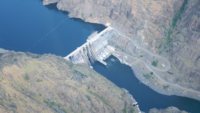
One reason why construction and finance industry officials are eager to see President Obama sign the Water Resources Reform and Development Act (WRRDA) is that it includes a new way to help narrow the infrastructure funding gap. The Water Infrastructure Finance and Innovation Act program (WIFIA) will provide federal loans and loan guarantees for Army Corps of Engineers and Environmental Protection Agency projects.
WIFIA's impact is likely to be much more modest than its model, the Dept. of Transportation's popular 16-year-old TIFIA, because its funding is significantly lower. The new water program also has restrictions that could limit its use.
WRRDA authorizes $350 million for WIFIA over five years. The funds, which reflect the cost of federal loan subsidies, are divided between the Corps and EPA. In 2015, each agency gets $20 million. Funding rises to $50 million each in 2019.
By comparison, 2014 TIFIA funding is $1 billion. Using TIFIA's leverage factor, each direct WIFIA dollar could support $10 in loans.
Many types of projects are eligible for WIFIA aid, including flood control, environmental restoration, dredging, locks and dams, drinking water, wastewater treatment and desalination.
Geoffrey Petrov, a partner with law firm Nossaman LLP, says WIFIA aid can cover up to 49% of a project's cost and thus is intended to supplement other sources. "It closes the gap for projects that are shovel-ready, essentially," he says.
The biggest restriction is that a project sponsor cannot use WIFIA aid and tax-exempt bond financing on the same project. The American Water Works Association would like to see that provision changed to allow tax-exempt financing for a project's non-WIFIA share.
Adam Krantz, a National Association of Clean Water Agencies managing director, notes that WRRDA also requires sponsors of wastewater-treatment projects to seek financing first from state revolving fund offices. A sponsor can apply to WIFIA only if the SRF agency says no. Krantz says the aim of that and some other WRRDA provisions "is to demonstrate that the SRF remains the primary Clean Water Act funding mechanism."
Despite WIFIA's limits, industry officials welcome the program. DJ Gribbin, a Macquarie Capital managing director, says, "Anything that encourages creativity in the funding of infrastructure is good because, for a variety of reasons that are lamentable, traditional funding sources are no longer adequate."
Scott Berry, director of the Associated General Contractors of America's utility infrastructure division, environment and trade, says, "It's probably net-beneficial to have a new type of program out there because at least it's something for the future that looks at a different way of financing than being stuck in the same old appropriations model year after year." Corps civil works and EPA water appropriations have been under heavy pressure.
Given WIFIA's small bankroll, loan-seekers may have to move fast. Petrov says, "I think the people that act first will be the ones who are rewarded under the pilot program."



Post a comment to this article
Report Abusive Comment